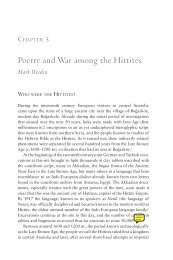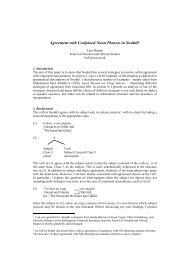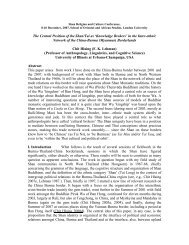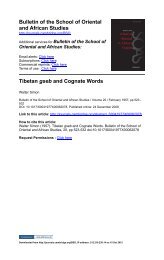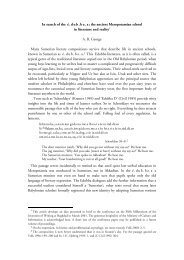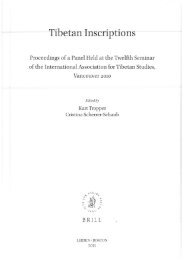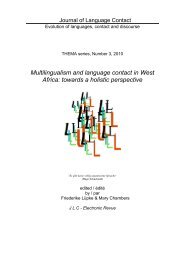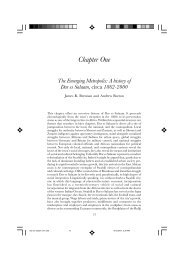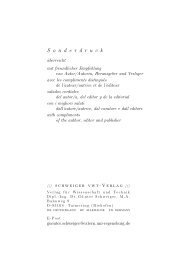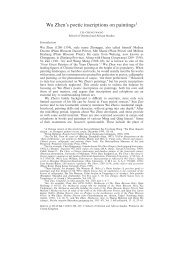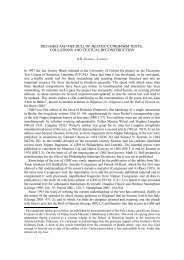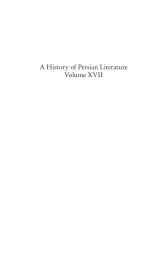Literarische Stoffe - The School of Oriental and African Studies
Literarische Stoffe - The School of Oriental and African Studies
Literarische Stoffe - The School of Oriental and African Studies
Create successful ePaper yourself
Turn your PDF publications into a flip-book with our unique Google optimized e-Paper software.
120<br />
Almut Hintze<br />
Hintze, A. (1994): Der Zamy¡d-Yašt. Edition, Übersetzung, Kommentar. Wiesbaden (Beiträge zur<br />
Iranistik. 15).<br />
—— (2000): ‘Lohn’ im Indoiranischen. Eine semantische Studie des Rigveda und Avesta. Wiesbaden<br />
(Beiträge zur Iranistik, 20).<br />
—— (2007): A Zoroastrian Liturgy: <strong>The</strong> Worship in Seven Chapters. (Yasna 35–41). Wiesbaden<br />
(Iranica, 12).<br />
HoÙmann, K. (1968): “<strong>The</strong> Avesta fragment FrD.3.” Indo-Iranian Journal 10, 282–288 (= Aufsätze<br />
zur Indoiranistik I, Wiesbaden, 1975, 221–227).<br />
—— (1986): “Avestisch Ù.” In: R. Schmitt & P.O. Skjærvø (eds.), Studia Grammatica Iranica.<br />
Festschrift für Helmut Humbach. München, 163–183 (= Aufsätze zur Indoiranistik III, Wiesbaden,<br />
1992, 837–857).<br />
—— & Forssman, B. (1996): Avestische Laut- und Formenlehre. Innsbruck (IBS 84).<br />
Humbach, H. (1955): “Die Genitivformen von idg. *dem- (ar. *dam-) ‘Haus’.” Münchener Studien zur<br />
Sprachwissenschaft, 6, 41–49.<br />
JamaspAsa, K.M. & Humbach, H. (1971): Pursišn£h¡. A Zoroastrian Catechism. 2 parts, Wiesbaden.<br />
Keith, A.B. (1920): Rigveda Brahmanas. <strong>The</strong> Aitareya <strong>and</strong> Kau£taki Br¡hma÷as <strong>of</strong> the Rigveda.<br />
Cambridge, Mass.<br />
Kellens, J. (1974): Les noms-racines de l’Avesta. Wiesbaden.<br />
—— (1996): “Commentaire sur les premiers chapitres du Yasna.” Journal Asiatique, 284, 37–108.<br />
Kirfel, W. (1920): Die Kosmographie der Inder nach den Quellen dargestellt. Bonn und Leipzig.<br />
Klingenschmitt, G. (1968): Farhang-i Ú£m. Edition und Kommentar. (Unpublished PhD<br />
dissertation, Erlangen).<br />
Markwart, J. (1930): “Das NaurÚz, seine Geschichte und seine Bedeutung.” In: Dr. Modi Memorial<br />
Volume. Papers on Indo-Iranian <strong>and</strong> other subjects written by several scholars in honour <strong>of</strong> Shamsul-Ulama<br />
Dr. Jivanji Jamshedji Modi. Bombay, 1930, 709–765B.<br />
Marquart, J. (1905): “Untersuchungen zur Geschichte von Eran.” Philologus, 195–215.<br />
Marshak, B.I. (1992): “<strong>The</strong> historico-cultural signiŸcance <strong>of</strong> the Sogdian calendar.” Iran, 30, 145–54<br />
(transl. from the Russian, with slight author’s changes, by W.J. Pittard).<br />
Mayrh<strong>of</strong>er, M. (1986–2001): Etymologisches Wörterbuch des Altindoarischen. Heidelberg.<br />
Mylius, K. (1995): Wörterbuch des altindischen Rituals. Wichtrach.<br />
Narten, J. (1982): Die AmçÙa Spç÷tas im Avesta. Wiesbaden.<br />
—— (1986): Der Yasna Hapta®h¡iti. Wiesbaden.<br />
Nilsson, M.P. (1920): Primitive time-reckoning. A study <strong>of</strong> the origins <strong>and</strong> first development <strong>of</strong> the art <strong>of</strong><br />
counting time among the primitive <strong>and</strong> early culture peoples. Lund.<br />
Panaino, A. (1990): “Calendars I. Pre-Islamic calendars.” In: E. Yarshater (ed.), Encyclopaedia Iranica<br />
4, 658–668.



